University Cyber Crime: Open Source Software and Proprietary Analysis
VerifiedAdded on 2023/06/09
|5
|1057
|441
Essay
AI Summary
This essay delves into the ongoing debate between open-source and proprietary software, particularly within the realm of cyber crime. It defines both software types, highlighting the open-source model's licensing agreements allowing code sharing and modification versus the proprietary model's secrecy and controlled access. The essay then compares the two based on several key factors: cost, innovation, usability, and availability. Open-source software is shown to be free, fostering greater innovation and availability, while proprietary software is expensive, with restricted user modification and requiring updates. By evaluating these comparisons, the essay concludes that open-source software is gaining an edge over proprietary software in the current business landscape. The essay also includes a comprehensive list of references to support the analysis.
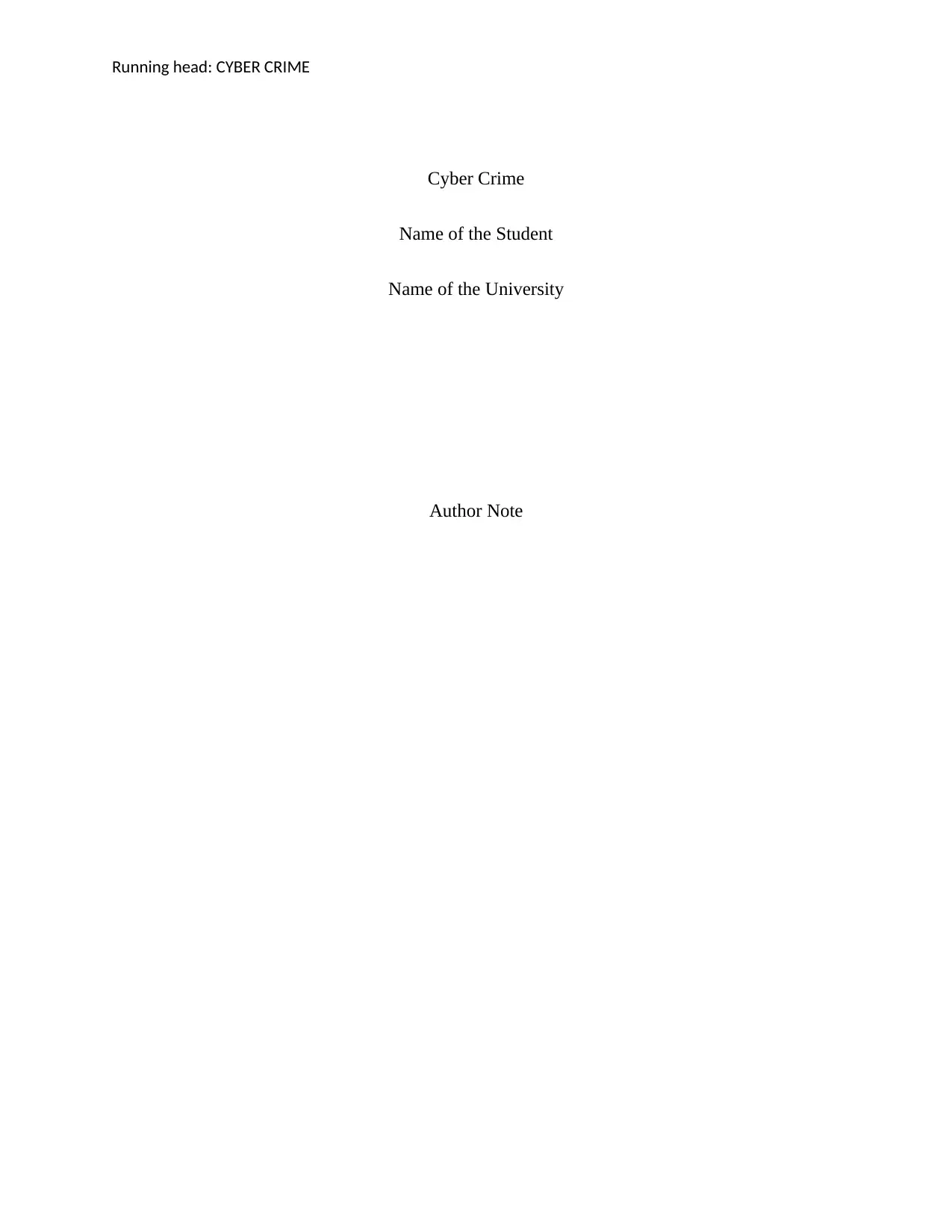
Running head: CYBER CRIME
Cyber Crime
Name of the Student
Name of the University
Author Note
Cyber Crime
Name of the Student
Name of the University
Author Note
Paraphrase This Document
Need a fresh take? Get an instant paraphrase of this document with our AI Paraphraser
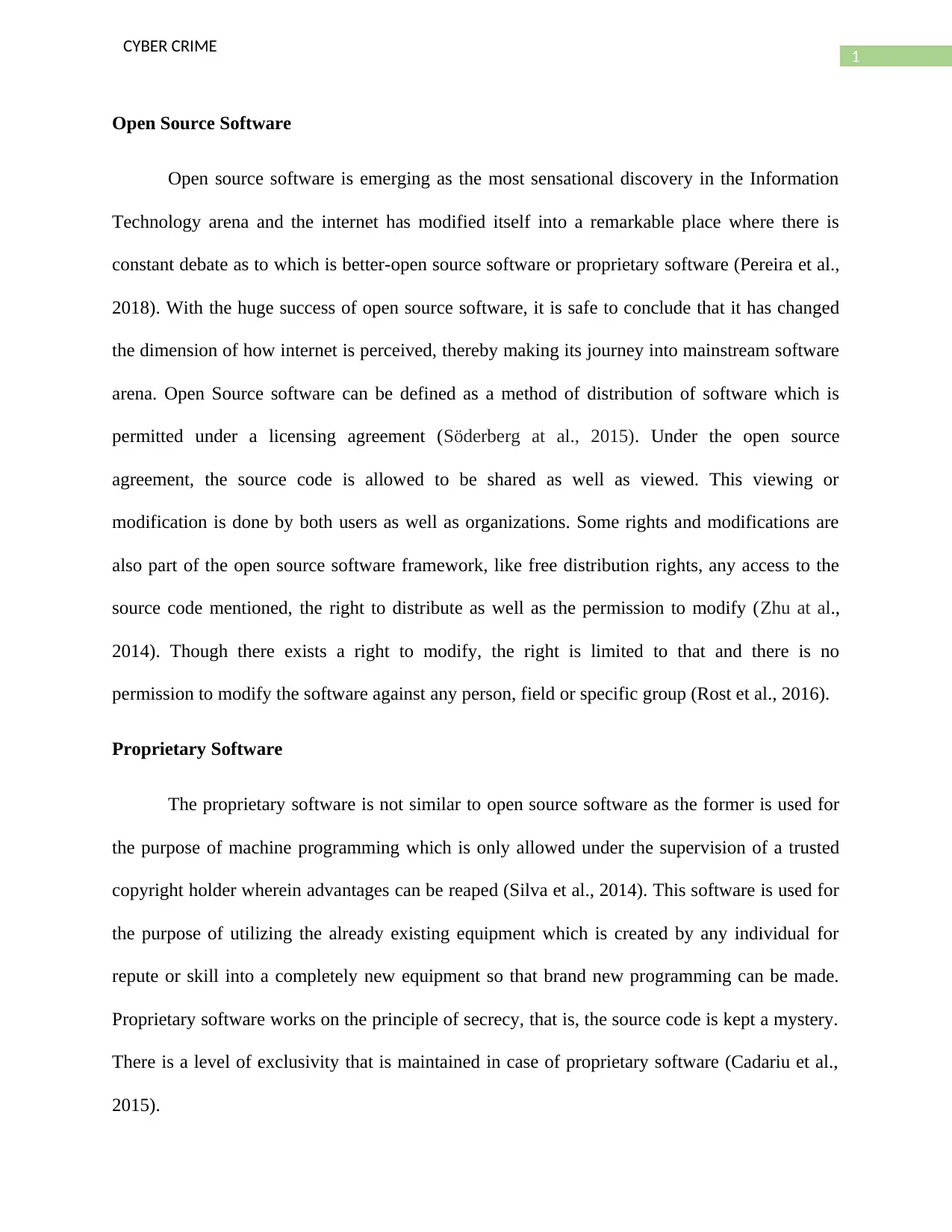
1
CYBER CRIME
Open Source Software
Open source software is emerging as the most sensational discovery in the Information
Technology arena and the internet has modified itself into a remarkable place where there is
constant debate as to which is better-open source software or proprietary software (Pereira et al.,
2018). With the huge success of open source software, it is safe to conclude that it has changed
the dimension of how internet is perceived, thereby making its journey into mainstream software
arena. Open Source software can be defined as a method of distribution of software which is
permitted under a licensing agreement (Söderberg at al., 2015). Under the open source
agreement, the source code is allowed to be shared as well as viewed. This viewing or
modification is done by both users as well as organizations. Some rights and modifications are
also part of the open source software framework, like free distribution rights, any access to the
source code mentioned, the right to distribute as well as the permission to modify (Zhu at al.,
2014). Though there exists a right to modify, the right is limited to that and there is no
permission to modify the software against any person, field or specific group (Rost et al., 2016).
Proprietary Software
The proprietary software is not similar to open source software as the former is used for
the purpose of machine programming which is only allowed under the supervision of a trusted
copyright holder wherein advantages can be reaped (Silva et al., 2014). This software is used for
the purpose of utilizing the already existing equipment which is created by any individual for
repute or skill into a completely new equipment so that brand new programming can be made.
Proprietary software works on the principle of secrecy, that is, the source code is kept a mystery.
There is a level of exclusivity that is maintained in case of proprietary software (Cadariu et al.,
2015).
CYBER CRIME
Open Source Software
Open source software is emerging as the most sensational discovery in the Information
Technology arena and the internet has modified itself into a remarkable place where there is
constant debate as to which is better-open source software or proprietary software (Pereira et al.,
2018). With the huge success of open source software, it is safe to conclude that it has changed
the dimension of how internet is perceived, thereby making its journey into mainstream software
arena. Open Source software can be defined as a method of distribution of software which is
permitted under a licensing agreement (Söderberg at al., 2015). Under the open source
agreement, the source code is allowed to be shared as well as viewed. This viewing or
modification is done by both users as well as organizations. Some rights and modifications are
also part of the open source software framework, like free distribution rights, any access to the
source code mentioned, the right to distribute as well as the permission to modify (Zhu at al.,
2014). Though there exists a right to modify, the right is limited to that and there is no
permission to modify the software against any person, field or specific group (Rost et al., 2016).
Proprietary Software
The proprietary software is not similar to open source software as the former is used for
the purpose of machine programming which is only allowed under the supervision of a trusted
copyright holder wherein advantages can be reaped (Silva et al., 2014). This software is used for
the purpose of utilizing the already existing equipment which is created by any individual for
repute or skill into a completely new equipment so that brand new programming can be made.
Proprietary software works on the principle of secrecy, that is, the source code is kept a mystery.
There is a level of exclusivity that is maintained in case of proprietary software (Cadariu et al.,
2015).
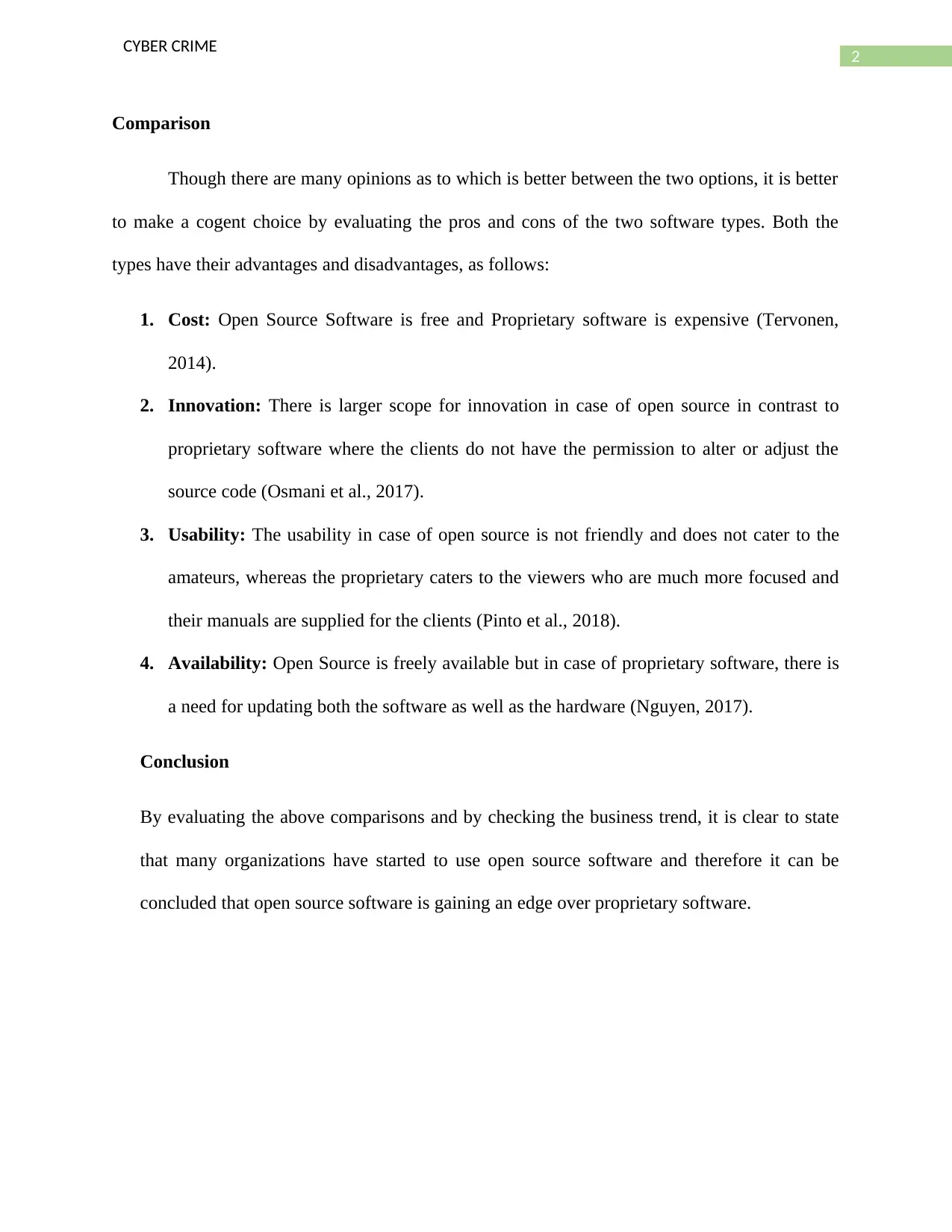
2
CYBER CRIME
Comparison
Though there are many opinions as to which is better between the two options, it is better
to make a cogent choice by evaluating the pros and cons of the two software types. Both the
types have their advantages and disadvantages, as follows:
1. Cost: Open Source Software is free and Proprietary software is expensive (Tervonen,
2014).
2. Innovation: There is larger scope for innovation in case of open source in contrast to
proprietary software where the clients do not have the permission to alter or adjust the
source code (Osmani et al., 2017).
3. Usability: The usability in case of open source is not friendly and does not cater to the
amateurs, whereas the proprietary caters to the viewers who are much more focused and
their manuals are supplied for the clients (Pinto et al., 2018).
4. Availability: Open Source is freely available but in case of proprietary software, there is
a need for updating both the software as well as the hardware (Nguyen, 2017).
Conclusion
By evaluating the above comparisons and by checking the business trend, it is clear to state
that many organizations have started to use open source software and therefore it can be
concluded that open source software is gaining an edge over proprietary software.
CYBER CRIME
Comparison
Though there are many opinions as to which is better between the two options, it is better
to make a cogent choice by evaluating the pros and cons of the two software types. Both the
types have their advantages and disadvantages, as follows:
1. Cost: Open Source Software is free and Proprietary software is expensive (Tervonen,
2014).
2. Innovation: There is larger scope for innovation in case of open source in contrast to
proprietary software where the clients do not have the permission to alter or adjust the
source code (Osmani et al., 2017).
3. Usability: The usability in case of open source is not friendly and does not cater to the
amateurs, whereas the proprietary caters to the viewers who are much more focused and
their manuals are supplied for the clients (Pinto et al., 2018).
4. Availability: Open Source is freely available but in case of proprietary software, there is
a need for updating both the software as well as the hardware (Nguyen, 2017).
Conclusion
By evaluating the above comparisons and by checking the business trend, it is clear to state
that many organizations have started to use open source software and therefore it can be
concluded that open source software is gaining an edge over proprietary software.
⊘ This is a preview!⊘
Do you want full access?
Subscribe today to unlock all pages.

Trusted by 1+ million students worldwide
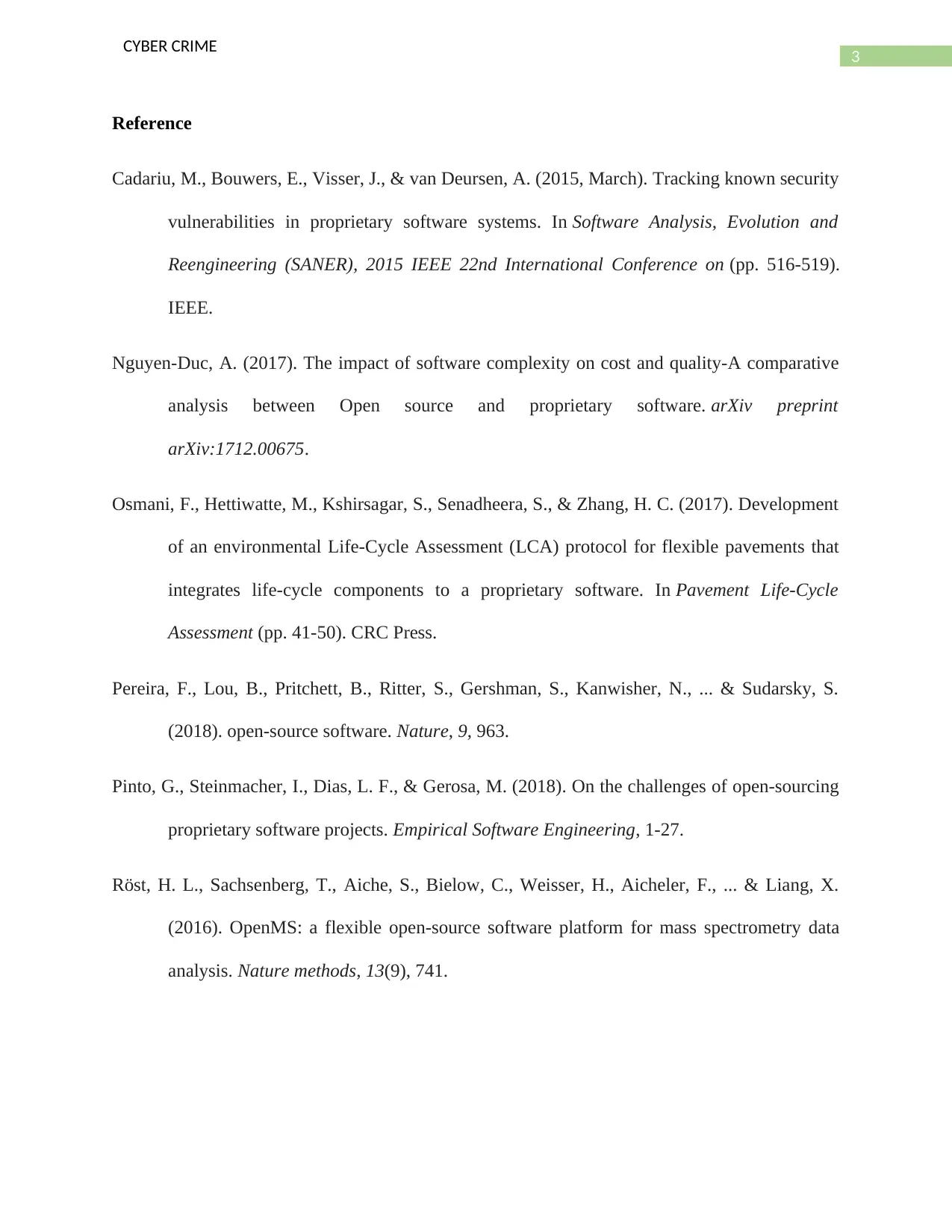
3
CYBER CRIME
Reference
Cadariu, M., Bouwers, E., Visser, J., & van Deursen, A. (2015, March). Tracking known security
vulnerabilities in proprietary software systems. In Software Analysis, Evolution and
Reengineering (SANER), 2015 IEEE 22nd International Conference on (pp. 516-519).
IEEE.
Nguyen-Duc, A. (2017). The impact of software complexity on cost and quality-A comparative
analysis between Open source and proprietary software. arXiv preprint
arXiv:1712.00675.
Osmani, F., Hettiwatte, M., Kshirsagar, S., Senadheera, S., & Zhang, H. C. (2017). Development
of an environmental Life-Cycle Assessment (LCA) protocol for flexible pavements that
integrates life-cycle components to a proprietary software. In Pavement Life-Cycle
Assessment (pp. 41-50). CRC Press.
Pereira, F., Lou, B., Pritchett, B., Ritter, S., Gershman, S., Kanwisher, N., ... & Sudarsky, S.
(2018). open-source software. Nature, 9, 963.
Pinto, G., Steinmacher, I., Dias, L. F., & Gerosa, M. (2018). On the challenges of open-sourcing
proprietary software projects. Empirical Software Engineering, 1-27.
Röst, H. L., Sachsenberg, T., Aiche, S., Bielow, C., Weisser, H., Aicheler, F., ... & Liang, X.
(2016). OpenMS: a flexible open-source software platform for mass spectrometry data
analysis. Nature methods, 13(9), 741.
CYBER CRIME
Reference
Cadariu, M., Bouwers, E., Visser, J., & van Deursen, A. (2015, March). Tracking known security
vulnerabilities in proprietary software systems. In Software Analysis, Evolution and
Reengineering (SANER), 2015 IEEE 22nd International Conference on (pp. 516-519).
IEEE.
Nguyen-Duc, A. (2017). The impact of software complexity on cost and quality-A comparative
analysis between Open source and proprietary software. arXiv preprint
arXiv:1712.00675.
Osmani, F., Hettiwatte, M., Kshirsagar, S., Senadheera, S., & Zhang, H. C. (2017). Development
of an environmental Life-Cycle Assessment (LCA) protocol for flexible pavements that
integrates life-cycle components to a proprietary software. In Pavement Life-Cycle
Assessment (pp. 41-50). CRC Press.
Pereira, F., Lou, B., Pritchett, B., Ritter, S., Gershman, S., Kanwisher, N., ... & Sudarsky, S.
(2018). open-source software. Nature, 9, 963.
Pinto, G., Steinmacher, I., Dias, L. F., & Gerosa, M. (2018). On the challenges of open-sourcing
proprietary software projects. Empirical Software Engineering, 1-27.
Röst, H. L., Sachsenberg, T., Aiche, S., Bielow, C., Weisser, H., Aicheler, F., ... & Liang, X.
(2016). OpenMS: a flexible open-source software platform for mass spectrometry data
analysis. Nature methods, 13(9), 741.
Paraphrase This Document
Need a fresh take? Get an instant paraphrase of this document with our AI Paraphraser
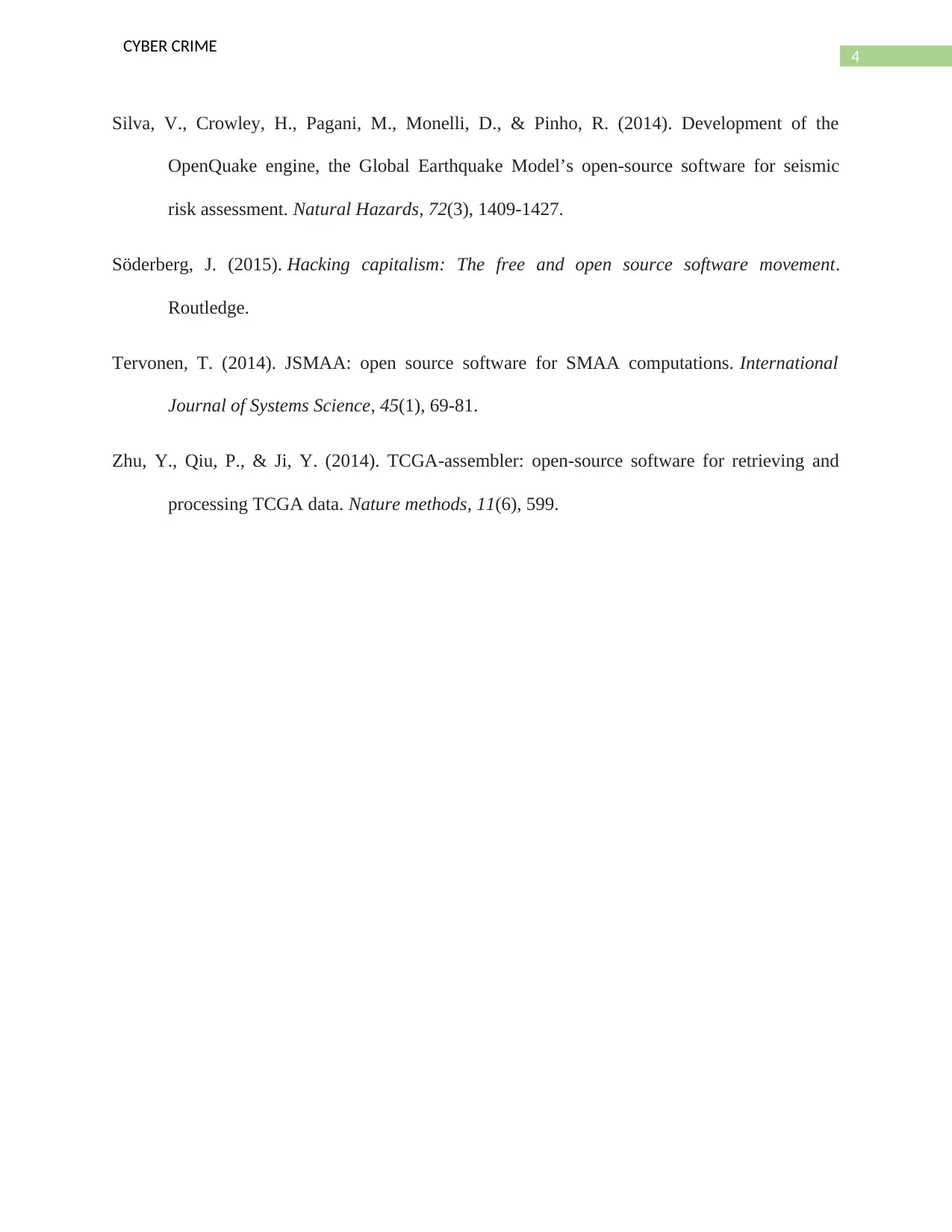
4
CYBER CRIME
Silva, V., Crowley, H., Pagani, M., Monelli, D., & Pinho, R. (2014). Development of the
OpenQuake engine, the Global Earthquake Model’s open-source software for seismic
risk assessment. Natural Hazards, 72(3), 1409-1427.
Söderberg, J. (2015). Hacking capitalism: The free and open source software movement.
Routledge.
Tervonen, T. (2014). JSMAA: open source software for SMAA computations. International
Journal of Systems Science, 45(1), 69-81.
Zhu, Y., Qiu, P., & Ji, Y. (2014). TCGA-assembler: open-source software for retrieving and
processing TCGA data. Nature methods, 11(6), 599.
CYBER CRIME
Silva, V., Crowley, H., Pagani, M., Monelli, D., & Pinho, R. (2014). Development of the
OpenQuake engine, the Global Earthquake Model’s open-source software for seismic
risk assessment. Natural Hazards, 72(3), 1409-1427.
Söderberg, J. (2015). Hacking capitalism: The free and open source software movement.
Routledge.
Tervonen, T. (2014). JSMAA: open source software for SMAA computations. International
Journal of Systems Science, 45(1), 69-81.
Zhu, Y., Qiu, P., & Ji, Y. (2014). TCGA-assembler: open-source software for retrieving and
processing TCGA data. Nature methods, 11(6), 599.
1 out of 5
Your All-in-One AI-Powered Toolkit for Academic Success.
+13062052269
info@desklib.com
Available 24*7 on WhatsApp / Email
![[object Object]](/_next/static/media/star-bottom.7253800d.svg)
Unlock your academic potential
Copyright © 2020–2025 A2Z Services. All Rights Reserved. Developed and managed by ZUCOL.

